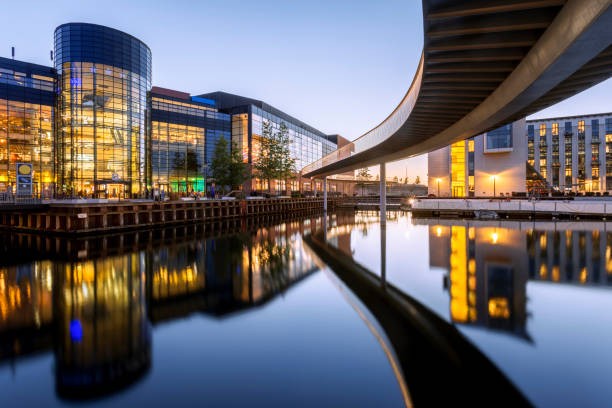The architectural identity of Denmark is a symbol to the rich history, innovation spirit and sustainability of the country. Since the Viking age up to the current times, the architecture of Denmark has developed mixing both the ancient and the modern architecture to produce a functional and beautiful architecture. Such a peaceful blend of past and the present does not only characterize the landscape of Denmark but also survey its culture and liberal nature.
Touring the architectural field of Denmark is a trip to the past where one can witness how the past has determined the current designs. The principles of sustainable practices and human oriented design that are committed to by the country also contribute to the architectural image of the country and make it an example to the cities of the world. As an architecture expert or an ordinary sightseer, learning more about the architecture development in Denmark will give you an insight into how architecture can be used to shape and depict the social values.
The Foundations of Denmark’s Architectural Identity
The history of architecture in Denmark started in the Viking Age and the constructions were mainly used in defense and dwelling. With the development of the country, the architecture of the country advanced as well with the use of Romanesque and Gothic architectural designs in the Middle Ages. The construction of churches, fortifications and castles which can be found today are built of stone due to the inability to get stone and the construction made use of brick which has been recorded as a representation of Denmark architecture. Wikipedia
The Rise of Modernism and Functionalism
The principles of modernism started being accepted in Denmark in the early 20 th century with practice on functionality and simplicity. Such architects as Arne Jacobsen, Poul Henningsen were the first to introduce designs that focused on clean lines, open spaces and use of industrial materials. It was also the time when the global impact of Denmark in the sphere of design commenced as the Danish modern furniture received the recognition of the global community.
The school of thought known as functionalism was adopted, which promoted the approach of designs that would be functional but not needless or decorated.
Sustainable Architecture-A Contemporary Requirement.
Over the past few decades, the concept of sustainability has been established as part of Danish architecture. The first carbon-neutral building, the Green Lighthouse in Copenhagen, and the waste-to-energy plant of Amager Bakke are just the examples of how the country is prepared to take care of the environment. These buildings also use renewable energy and energy efficient designs with sustainable materials in order to reduce their ecological footprint. architecturequote.com.
An anthropocentric Design: Putting people first.
The architectural character of Denmark is based on privileging human well-being. The philosophy of urban planner Jan Gehl lays focus on the need to design cities with a greater emphasis on pedestrians and cyclists, which create a social atmosphere and a feeling of community.
Typical examples of Danish architecture.
There are several masterpieces of architectural works in Denmark that reflect their rich architectural culture and innovation. Copenhagen Round Tower is an example of the historical interest of the country in science and education, and the tower was constructed in the seventeenth century as an observatory. One of the modern cultural buildings, the Royal Danish Playhouse by Lundgaard and Tranberg, fits into the waterfront environment perfectly well.
The Cactus Tower in Vesterbro and the Cykelslangen (Bicycle Snake) in Copenhagen points to the innovative attitude towards the incorporation of green areas and stimulation of sustainable transportation in Denmark. These buildings do not merely fulfill their practical roles, but also create aesthetic and environmental excellence to the cityscape.
Architectural Identity in the Global context of Denmark.
The architectural identity of Denmark has earned the country a global following with regard to innovative designs and sustainability. Such architects as Bjarke Ingels of BIG have translated Danish design ethos into the international arena, and the projects such as Amager Bakke waste-to-energy plant and 8 House in Copenhagen have demonstrated how the country is progressive in its architecture.
The focus of the country on sustainable city growth, people-based design, and introduction of nature into the architectural environment have contributed to the development of architecture in the rest of the world.
Visiting Denmark: Architectural Beauties to Plan.
To the people who are not indifferent to see the beauty of architecture in Denmark, the first step is to get a Denmark visiting visa. It is not complicated, as one has to demonstrate accommodation, travel plan and a financial ability to cover the stay period. The applicants also have to submit valid travel documents and might have to prepare an interview at the closest Danish consulate or embassy.
To UAE residents, applying to Denmark visit visa is equally available. The process is done by applying with the required documents such as evidence of travel plans and financial stability to the Danish mission based in the UAE.
Conclusion:
The architectural identity of Denmark is a heritage to its rich history, innovative spirit and desire to be sustainable. Since the Viking Age to the current era, Danish architecture has been in its developmental stage incorporating the traditional forms with the modern structures to come up with structures that are functional and beautiful.
The architectural scenery in Denmark will be a time traveler in the truest sense of the word, as it presents people with the way historical forces have shaped the modern designs. The commitment of the country to sustainable practices and human-oriented principles of design further contribute to the identity of the country in terms of architecture, which makes it an example to other cities in the world. Be it an architecture lover or just a mere onlooker, learning about the architectural development in Denmark will be insightful as to how design can shape and capture the values in a society.
